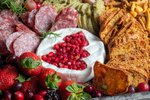
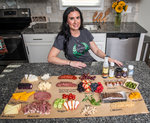
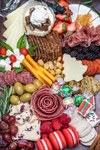
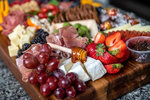
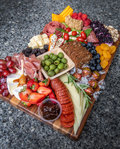
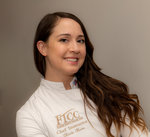

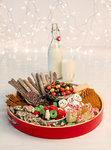
It starts with color choices, then maybe some added textures. Shapes and angles are important, too, and here and there, some depth.
Soon, you’ll have a masterpiece that will make the ordinary simply extraordinary and whet the appetites of those who appreciate your vision.
And then, what everybody came for: Dig in and destroy that masterpiece.
For Lindsey Smith, building a charcuterie board is like painting a landscape or sculpting a statue. The result is a work of art.
“It’s totally food art,” says Smith, who’s also known as The Charcuterie Chic. “I was always that kid who could not fill in the colors in the lines in art class. But with charcuterie, you work with shapes and colors to get that ‘wow’ factor. You have to make an impression.”
Something about the variety of tastes in one small space appeals to Smith. In restaurants, she often orders the appetizer sampler because she can’t decide on one dish.
Sarah Wassberg Johnson, who is known online as The Food Historian, says charcuterie boards have working-class roots that can be traced to Medieval times throughout Europe. Cheeses, bread, and wine or beer were often paired with cured meats, fruits and pickled vegetables as standard peasant laborer fare. The meals were portable, did not have to be kept cool, and required few utensils to eat.
Charcuterie gained popularity in America in the early 1900s when cocktail parties and midnight suppers — usually eaten after a concert or theater performance — took hold, Johnson says.
Lindsey Smith was a clinical psychologist repairing troubled marriages and helping people struggling with substance abuse when she lived in California. When her husband, an Army veteran, took a contractor job at Fort Bragg, the Smiths moved to Fayetteville.
Being thousands of miles from home was unsettling at first, but Smith joined a gym, met some new friends and started looking for a second career. She loves to cook but was also drawn to charcuterie. At the time, what’s now trendy seemingly everywhere had not quite made it to Fayetteville. So she found an opening building charcuterie boards and teaching others the magic behind it.
She opened The Charcuterie Chic in January 2020. At the time, of course, COVID-19 was a challenge, but she built a following with porch-pickup orders at a time when most restaurants had suspended indoor dining.
Her business now includes weddings and parties as well as corporate “bonding” experiences to help employees with teamwork. She also leads charcuterie workshops in Fayetteville, Southern Pines and the Triangle as well as on Fort Bragg.
“The workshops keep selling out because they’re so much fun,” says Smith, who hopes one day to open a storefront.
For some catering jobs, she skips the board and uses a full table. Cake stands and other serving pieces add different levels to enhance the aesthetic appeal. She once built a charcuterie on an 18-foot table to feed 150 guests.
Her holiday board special feeds eight and costs $80.
Smith has a method to her board designs, but she’s also free-spirited.
“I start with the cheese because cheese is my favorite,” she says.
Next, she adds the meats, pairing cheeses and meats that complement each other with a balance of flavor. Brie and prosciutto are a winner, as are pepperoni and machingo cheese, Smith says.
Add fruits such as grapes or berries to elevate the acidic taste or sweetness, she says. Olives are almost a must to balance the sweet.
Dips and spreads can be the finishing touches, including white truffle sauce — her favorite — and fig-honey jam or balsamic glaze.
“It’s the little details,” she says, that create the magic.
“Twenty people can build on the same board with the same ingredients and they will all look different.”
The finishing touch is to pair a beer or wine that complements what’s on the board, Smith says.
For a recent interview, Smith laid out her ingredients in separate piles on brown kitchen paper. She used a marker to label each cheese and meat and other ingredients. On a board that was half the surface of the kitchen paper, she pieced the elements together as if she were creating a work of art.
And she shared a favorite trick to form a perfect salami “rose.” Using a champagne flute — one with no stem — she artfully folded slices of salami over the rim, layering them carefully. When done, she turned the flute upside down and released the bundle of cured meat shaped to look like flower petals.
“I love putting my own spin on it,” Smith says.
Perhaps nothing better exemplifies the fact that charcuterie boards are super-trendy than that the art has become part of the curriculum for students in the culinary arts program at Fayetteville Technical Community College.
Nicole Knotts, FTCC’s coordinator of culinary instructional events, explains that garde manger — French for an area of the kitchen where cold foods are prepared — is taught as part of the coursework to prepare students to pursue careers in food service, including as line cooks, sous chefs and caterers.
Garde manger would include preparing cold hors d’oeuvres, dressings and salads, and even cheesemaking, Knotts says.
FTCC’s culinary program currently has 96 students, with another 12 in a certificate program.
Knotts is temporarily based in the kitchen of the Tony Rand Student Center while construction is underway on a culinary arts building. On Veterans Day, she was in charge of catering for a reception after a ceremony honoring those who served.
To demonstrate how charcuterie boards are created, she designed three with slightly different themes.
A big board had traditional elements like blueberry goat cheese; brie with pomegranate seeds shaped like a Christmas tree; Genoa salami; prosciutto; sesame toasts; focaccia; and fruits and beer nuts.
Board No. 2, served on a marble slab, was lighter on the meats, featuring Yorkshire cheese with cranberries; brie with honeycomb-pecan drizzle; spicy Chorizo; Swiss-almond cheese spread; spicy cupola cheese; and Italian bread straws.
A third option was one with the kids in mind. Because their young palettes are not likely to go for cured meats and spicy cheeses, this Christmas-themed board served up peppermint sticks; Rice Krispie treats; marshmallow snowmen; ginger snaps; chocolate-swirled pretzel sticks; and ginger star cookies.
Knotts says she typically uses three cheeses — one soft, one hard and one in between — and two to three meats.
She starts with greenery — typically rosemary — then places the utensils and garnishes with fruit.
“The fill-in comes with a little fluff,” she says. “Sometimes you can be a little haphazard with it, and things fall into place when the tray is full.”
“It’s a good activity to do together,” Knotts adds.
She tries to use locally sourced products, including cheese from Ithika Acres Creamery, a goats’ milk dairy in Raeford.
They say we eat with our eyes, and perhaps there’s no better example of that than charcuterie boards. Lindsey Smith knows that to be true.
“Sometimes, people will say, ‘It’s too pretty to eat,’” Smith says. “But I’d be offended if you don’t eat it.”
Often, it’s left to the host to be the first one to dive in.
Just remember to take photos first.